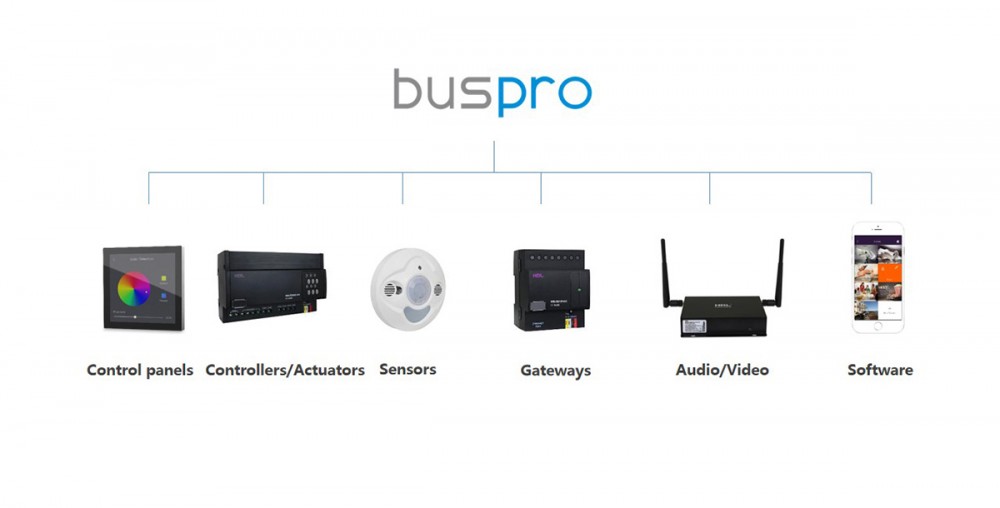
HDL Buspro:
HDL Buspro is a smart system for homes, commercial buildings, and hotels. It is able to integrate lighting, shading, HVAC, background music, security, and other features. It allows users to control everything on a mobile app, PC program, or a wall panel. What’s more, with
sensors and logic settings, tasks can be automatically run by the system as well.
Yes, the HDL Buspro protocol is a communication protocol used in smart building automation systems. It enables various devices and systems to communicate and work together, allowing for centralized control of lighting, HVAC, security, and other electrical systems. The protocol supports both wired and wireless communication and is designed to ensure compatibility and interoperability among different devices. If you have specific questions or need details about
certain aspects, feel free to ask!
Sure! Here’s a more detailed overview of the HDL Buspro protocol:
Key Features:
1. Two-Wire System: The protocol operates on a two-wire bus system, which simplifies installation and reduces the amount of wiring needed in a building.
2. Interoperability: Devices from different manufacturers can communicate over the Buspro protocol, enhancing flexibility in system design and upgrades.
3. Real-Time Control: Users can monitor and control devices in real-time through various interfaces, including wall-mounted panels, mobile applications, and tablets.
4. Scalability: The system can be easily expanded to accommodate new devices and functionalities, making it suitable for both small and large installations.
5. Intelligent Functions: Supports advanced automation features such as scheduling, scene control, and energy management, enabling users to optimize energy usage and enhance comfort.
6. User-Friendly Interface: The system is designed for ease of use, allowing users to create customized settings and control their environment effortlessly.
7. Integration with Other Systems: HDL Buspro can be integrated with other smart home systems, enhancing overall functionality and user experience.

Applications:
- Residential Buildings: For automated lighting control, climate control, and security systems.
- Commercial Spaces: In offices and retail environments for energy efficiency and improved user comfort.
- Industrial Applications: For monitoring and controlling machinery and processes.
Components
1. Buspro Devices:
Control Panels: Wall-mounted interfaces that allow users to control lighting, HVAC, and other systems.
Sensors: Motion, temperature, and light sensors that provide feedback to the system for automated responses.
Actuators: Devices that control the physical operation of electrical systems, such as dimmers, relays, and motorized blinds.
2. Communication Method:
Wired Communication: Utilizes a two-wire system that reduces installation
complexity and cost while ensuring reliable communication.
Wireless Options: Some devices may offer wireless connectivity for added flexibility.
3. Software Tools:
Configuration Software: Used for setting up and programming the Buspro system, allowing for custom scenes, schedules, and automation rules.
Monitoring Tools: Applications that provide users with insights into energy usage and system performance.
Advantages
1. Reliability:
The two-wire design ensures a stable connection, minimizing signal loss and enhancing system reliability.
2. Energy Efficiency:
Advanced energy management features help reduce energy consumption, contributing to sustainability efforts.
3. Flexibility and Customization:
Users can tailor their automation systems to fit specific needs and preferences, creating personalized environments.
4. Remote Access:
Users can control and monitor their systems remotely through mobile apps, providing convenience and security.
5. Integration Capabilities:
Can easily integrate with existing building management systems (BMS) and IoT devices, enhancing functionality.

Typical Use Cases
1. Residential Applications:
Smart Homes: Automate lighting scenes based on time of day or occupancy, manage HVAC systems efficiently, and enhance security with integrated alarm
systems.
Energy Monitoring: Track energy usage in real-time and receive alerts for unusual consumption patterns.
2. Commercial Spaces:
Office Buildings: Centralized control of lighting and climate for different zones, improving employee comfort and productivity.Retail Environments: Dynamic lighting and display controls to enhance the shopping experience and optimize energy use.
3. Hospitality:
Hotels: Provide guests with control over room lighting, temperature, and entertainment systems, enhancing their experience.
4. Industrial Applications:
Factory Automation: Monitor and control machinery, optimize production processes, and ensure safety compliance through automated alerts.
5. Healthcare Facilities:
Patient Comfort: Adjust lighting and climate settings automatically based on patient needs and occupancy, improving care environments.
Future Trends
IoT Integration: Increased connectivity with IoT devices will enhance data collection and automation capabilities.
AI and Machine Learning: Incorporating AI to predict user preferences and optimize energy management dynamically.
Enhanced User Interfaces: Continued development of intuitive apps and interfaces for easier control and monitoring.



